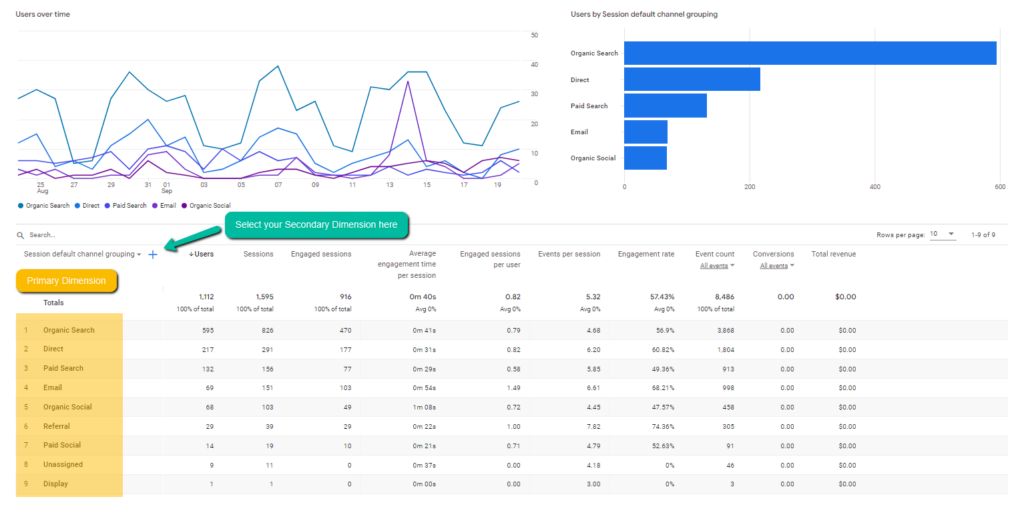Optimizing SEO with Secondary Dimension in Google Analytics
Optimizing SEO with Secondary Dimension in Google Analytics
Blog Article
Enhance Your Information Analysis Using Additional Measurement in Google Analytics
Checking out the capabilities of second dimensions in Google Analytics opens a realm of opportunities for refining information analysis. By layering added dimensions onto key information sets, an even more intricate narrative emerges, dropping light on individual interactions and performance signs.
Recognizing Secondary Measurements
Additional dimensions in Google Analytics refer to additional parameters that can be added to the key dimension, enabling for a much more in-depth evaluation of data (Secondary Dimension in Google Analytics). By integrating second dimensions, experts can section and filter data to reveal patterns, fads, and connections that may not be obvious when looking at the data as a whole.

Benefits of Utilizing Second Dimensions
When evaluating data in Google Analytics, the use of second measurements provides invaluable understandings right into user actions and performance metrics. By including a secondary dimension to your primary information, you can dive deeper right into the characteristics of your internet site visitors and their communications.
Additionally, secondary dimensions aid in identifying patterns and correlations that may not be instantly apparent when looking at the data alone. This deeper level of analysis can uncover beneficial details that can direct advertising techniques, site optimization, and overall business decisions. Additionally, additional measurements improve the context of your primary data, providing a much more detailed sight of individual engagement and efficiency metrics. On the whole, using secondary dimensions in Google Analytics can considerably improve the deepness and high quality of your information analysis, bring about more educated decision-making and boosted outcomes.
Exactly How to Add Second Measurements
By integrating secondary measurements in Google Analytics, customers can obtain deeper insights right into their information analysis procedure, permitting more thorough analysis of individual behavior and efficiency metrics. Adding secondary dimensions is a straightforward procedure that can considerably boost the depth of evaluation. To include a secondary measurement in Google Analytics, beginning by navigating to the report you intend to assess. As soon as in the report, situate the "Additional dimension" tab above the information table. Click on it to reveal a dropdown menu with various choices such as Behavior, Modern Technology, and Personalized Capacities. Select the measurement you wish to add, such as 'Source/Medium' or 'Tool Category'. This secondary measurement will certainly after that be put on your existing information, offering additional context and permitting a more comprehensive analysis of individual communications. By using secondary measurements effectively, customers can discover beneficial understandings that might have otherwise been overlooked, leading to educated decision-making and boosted efficiency approaches.
Analyzing Information With Secondary Dimensions
Utilizing second dimensions in information evaluation offers a more thorough understanding of individual behavior and performance metrics. By adding an additional measurement to your main information embeded in Google Analytics, you can dive much deeper right into the attributes of your site visitors and their communications. As an example, integrating the main measurement of 'source/medium' with the additional dimension of 'landing page' can disclose which details web pages are attracting web traffic from different resources, helping you optimize these pages for much better interaction.

Basically, evaluating information with additional dimensions equips you to obtain important understandings wikipedia reference into individual behavior, identify patterns, and make notified choices to enhance the performance of your digital properties.
Finest Practices for Second Measurements
In data evaluation, incorporating additional dimensions successfully can considerably enhance the depth of understandings stemmed from metrics and customer habits patterns. When using secondary dimensions in Google Analytics or any various other analytical device, it is vital to comply with best techniques to make sure the accuracy and significance of the data evaluation.
One secret ideal method is to thoroughly select additional measurements that enhance the key dimension being analyzed. Selecting secondary measurements that offer over at this website added context or more division can use a much more thorough understanding of the data. It is additionally essential to stay clear of overcomplicating the analysis by including way too many second measurements, which might result in confusion or dilution of insights.
Furthermore, it is a good idea to try out various mixes of secondary and main dimensions to reveal new correlations and fads. Frequently assessing and refining the option of second dimensions based on the certain objectives of the analysis can cause more workable understandings. By complying with these ideal techniques, information analysts can utilize additional dimensions effectively to enhance the general information analysis procedure and decision-making capacities.

Conclusion
Finally, incorporating second measurements in Google Analytics is important for a comprehensive data evaluation technique. By leveraging second dimensions alongside main ones, marketers and analysts can uncover useful insights and relationships that can notify decision-making and enhance electronic advertising methods. Recognizing exactly how to efficiently utilize additional measurements and complying with best practices will certainly enable professionals to extract meaningful data and improve their general performance metrics.
Additional measurements in Google Analytics refer to additional parameters that can be included to the primary dimension, permitting for an extra detailed analysis of information. By incorporating additional dimensions, analysts can sector and filter information to uncover patterns, trends, and connections that may not be apparent when looking at the information as a whole. Combining the primary dimension of 'source/medium' with the secondary measurement of 'landing page' can reveal which specific web pages are bring see in web traffic from various sources, helping you enhance these web pages for better involvement.
One trick best method is to meticulously pick secondary measurements that match the main measurement being assessed. By adhering to these finest practices, information analysts can leverage second dimensions effectively to enhance the general information evaluation procedure and decision-making capacities.
Report this page